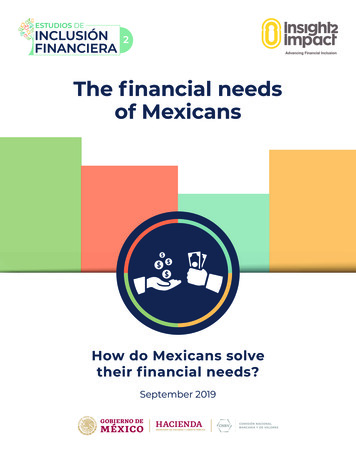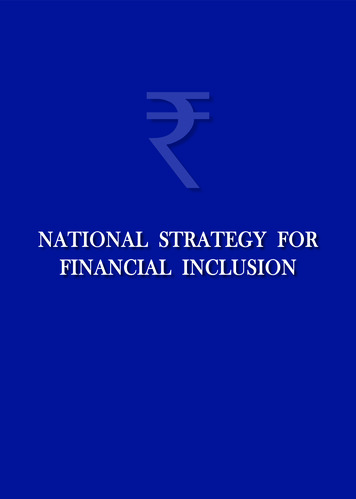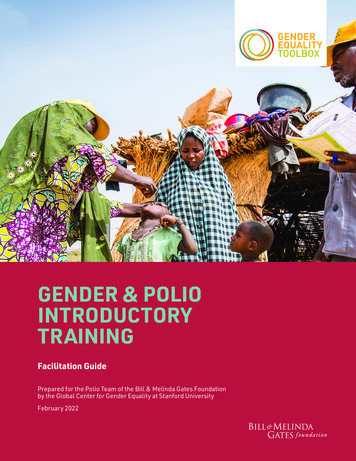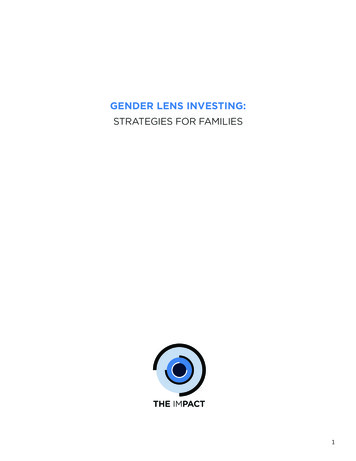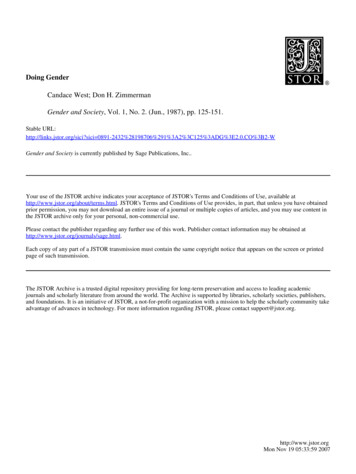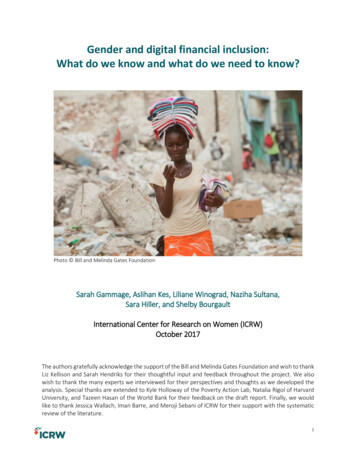
Transcription
Gender and digital financial inclusion:What do we know and what do we need to know?Photo Bill and Melinda Gates FoundationSarah Gammage, Aslihan Kes, Liliane Winograd, Naziha Sultana,Sara Hiller, and Shelby BourgaultInternational Center for Research on Women (ICRW)October 2017The authors gratefully acknowledge the support of the Bill and Melinda Gates Foundation and wish to thankLiz Kellison and Sarah Hendriks for their thoughtful input and feedback throughout the project. We alsowish to thank the many experts we interviewed for their perspectives and thoughts as we developed theanalysis. Special thanks are extended to Kyle Holloway of the Poverty Action Lab, Natalia Rigol of HarvardUniversity, and Tazeen Hasan of the World Bank for their feedback on the draft report. Finally, we wouldlike to thank Jessica Wallach, Iman Barre, and Meroji Sebani of ICRW for their support with the systematicreview of the literature.1
Table of ContentsAbbreviations . 31.Introduction . 42.Background and Approach . 63.Methodology and Data . 104.Findings . 155.6.7.4.1.Findings: Access . 174.2.Findings: Use . 214.3.Findings: Outcomes. 24Discussion. 275.1.Norms and Social Institutions . 315.2.Preferences . 335.3.Intra-Household Bargaining . 355.4.Labor Market Participation and Time Use . 395.5.Poverty, Resilience, and Economic Security . 435.6.Supply-Side Considerations. 455.7.Negative Impacts . 47Conclusions and Recommendations . 526.1.Conclusions . 526.2.Recommendations . 55References . 58Appendix A: List of Experts Who Took Part in ICRW Key Informant Interviews . 64Appendix B: Correlations of Key Themes for which the Publications in the Systematic Review wereCoded . 65Appendix C: Venn Diagrams Depicting Overlaps between Several Key Themes in the FI and DFILiterature Included in the Systematic Review . 662
AbbreviationsBMGFBill & Melinda Gates FoundationCGAPConsultative Group to Assist the PoorDFIDigital financial inclusionFIFinancial inclusionG2PGovernment-to-personGBVGender-based violenceICRWInternational Center for Research on WomenIMFInternational Monetary FundIPAInnovations for Poverty ActionIPVIntimate partner violenceLFPLabor force participationMENAMiddle East and North AfricaMGNREGSMahatma Gandhi National Rural Employment Guarantee SchemeP2PPerson-to-personQ2Mixed-methods (qualitative and quantitative)RCTRandomized controlled trialROSCARotating savings and credit associationSHGSelf-help groupSMEsSmall and medium enterprisesVSLAVillage savings and loan associationWEWomen’s empowermentWEEWomen’s economic empowerment3
1. IntroductionBetter and more meaningful financial inclusion may prove to be the key to unlocking the potential formicro and small enterprises to grow, reducing the exposure of poor and rural communities to incomeshocks, dynamizing growth, and promoting more sustainable and equitable development. Recent analysisof financial inclusion underscores that where individuals have access to financial services and products,even in poor communities, they are better able to plan and manage their income (Ruiz, 2013) andhouseholds are more likely to hold savings and to invest these savings in productive uses (Schaner, 2016b).Controlling for income and sector of employment, households that have access to savings instrumentsand insurance are better able to withstand economic shocks (Karlan et al., 2014; Janzen and Carter, 2013;Cole et al., 2013); they are also more able to invest in education for their children and purchase healthcareservices (Prina, 2015; Dupas and Robinson, 2013a; Duflo, 2012; Bauchet et al., 2011). Communities inwhich a greater proportion of the members are banked are more likely to have higher incomes (Bruhnand Love, 2014) and experience lower poverty rates (Kast and Pomeranz, 2014; Burgess and Pande, 2005),denser economic activity, stronger forward and backward linkages to productive activities, and more andbetter employment opportunities (Bruhn and Love, 2011). Indeed, Beck et al. (2007) find that controllingfor other relevant variables, 30 percent of the variation in rates of poverty reduction can be attributed tocross-country variation in financial development.Better and more meaningful financial inclusion may also foster reducedgender inequalities. Women who have access to bank accounts, savingsmechanisms, and other financial services may be better able to control theirearnings and undertake personal and productive expenditures (Islam et al.,2014; Alam, 2012; Ashraf et al., 2010). They may also be able to make morechoices about how they use their time, whether for employment, leisure,income-generating activities, or education (Field et al., 2016; Bandiera et al.,2013; Aker et al., 2016). They may have more substantive autonomy over theirlives in decisions ranging from employment and marriage to whether to usecontraception (Holloway et al., 2017; Suri and Jack, 2016; Pitt et al., 2006; Akeret al., 2016; de Brauw et al., 2014; Schuler and Hashemi, 1994). They may bebetter able to grow their businesses, to choose where and how to work (Fieldet al., 2016), and to raise their productivity and earnings and reduce theirchances of being poor (Suri and Jack, 2016; Swamy, 2014). They may also havemore options to leave abusive relationships and experience reduced exposureto intimate partner violence (Panda, 2014; Garikipati, 2008).Yet untapped opportunities exist to provide a broader array of financialservices for the poor and particularly for women. Conventional financialproducts and services still do not seem to reach the poor and women well.According to the 2014 Global Findex data, 57 percent of women around theworld have a financial account, compared to 64 percent of men (DemirgüçKunt et al., 2015). Furthermore, the International Finance Corporationestimates that over 70 percent women-owned small and medium enterprises(SMEs) have inadequate or no access to financial services (Koch et al., 2014).The gender gap has persisted despite the growth in the number of people withaccess to financial services, and the gap is largest among the poor: poorwomen are 28 percent less likely than poor men to have a formal bankaccount (Demirgüç-Kunt et al., 2013).This report builds on thework of Cultural Practice,LLC, which receivedsupport from the Bill andMelinda GatesFoundation in 2013 toproduce a report titled“Understanding GenderDifferences in Accessingand Using DigitalFinancial Services andIdentifying Opportunitiesfor IncreasingParticipation by Women:A Review of theLiterature.”The systematic reviewconducted by theInternational Center forResearch on Women(ICRW), supported by theBill and Melinda GatesFoundation, delves intothe financial inclusionliterature and identifiesgaps in research andpractice to inform thefield going forward.4
But as new products and services delivered through low-cost platforms emerge, the opportunities to bankthe unbanked and promote meaningful financial inclusion are multiplying. Digital financial services appearto offer innovative platforms to address financial exclusion. Digital platforms have the potential toovercome restrictions brought on by geography, reduce the transactions costs of using financial services,and enhance transparency and therefore increase trust in financial systems. By enabling financial datacapture and storage, digital platforms can also help reduce the informational asymmetries betweenlenders and borrowers that keep large segments of mostly poor populations excluded from financialsystems. They can also improve financial autonomy and privacy for users and potentially reduce the riskof cooption and appropriation of these funds by others.Despite significant investments in mobile platforms and some prominent successes digitizing paymentsand transfers, women tend to face barriers to accessing and using digital financial services. Since digitalfinancial services typically rely on mobile communications networks, access to mobile technology and theability to use it, how and when desired, are critical factors in determining digital financial inclusion. Indeed,GSMA (2015) estimates that women are 14 percent less likely than men to own a mobile phone. Themobile gender gap is wider in some parts of the world, such as in South Asia, where women are 38 percentless likely to own a phone. There is a smaller gender gap in Sub-Saharan Africa, though there aresubstantial variations across the region, particularly between East Africa, where rates of mobile phoneownership for both men and women tend to be relatively high, and countries like Niger and DemocraticRepublic of the Congo, where women’s likelihood of owning a mobile phone is 45 percent and 33 percentlower than that of men, respectively. If fewer women own mobile phones, fewer women are able toregister phone-based financial accounts in their names, preventing them from fully accessing variousdigital financial services, like making or receiving money transfers, receiving credit, paying bills, andmaking decisions about their use.Critically examining the current body of evidence can reveal the barriers for women to financial inclusionand can inform best practices for effectively engaging them through digital platforms and media. Thisreport provides an overview of the field of gender and financial inclusion, particularly digital financialinclusion, undertaking a systematic review of key literature in the field and developing a gap analysisbased on the key themes and geography that describe where the research and policy efforts have beenconcentrated to date. The report aims to identify areas for further research and opportunities to delvedeeper into issues of gender and digital financial inclusion with a view to promoting and sustaininginclusive and more equitable growth and local development.As a strategic research partner to the Bill & Melinda Gates Foundation (BMGF)’s Financial Services for thePoor portfolio, the International Center for Research on Women (ICRW) has undertaken a systematicreview to explore recent research on gender and financial inclusion and gender and digital financialinclusion to inform the broader donor and practitioner field about gaps in and opportunities forinvestments in both research and interventions. Specifically, the following were the key objectives of thereview:1. To understand where and how gender influences financial inclusion and digital financial inclusion.2. To represent the strength of the evidence base to show what the field knows and where thereare gaps.3. To highlight potential questions and knowledge gaps to inform a learning agenda for the widerfield and future investments.5
2. Background and ApproachBuilding on earlier work by Cultural Practice (2013) and an initial scan of evidence1, ICRW has conducteda systematic review that delves into the financial inclusion (FI) literature and identifies gaps in researchand practice to inform the field going forward.This report explores the key domains of research and evaluation around gender and financial inclusionand gender and digital financial inclusion that address access, use, and outcomes of inclusion, focusingspecifically on the bottom of the pyramid and the most excluded and vulnerable populations.Meaningful financial inclusion implies not just access but also use, since access alone does not necessarilylead to active use of financial accounts and services (see Box 1). We therefore cannot consider accessalone to be a sufficient indicator of financial inclusion—it must also involve active use of the financialservices and products.In addition to focusing on access and use, we also look at the outcomes associated with financial inclusionto see what its implications are in terms of individual, household, and collective welfare and wellbeing. IfBox 1: Defining Financial InclusionIn this report, we define meaningful financial inclusion as accessto and use of financial products and services. This definition wasinformed by both the systematic literature review and interviewswith subject matter experts in the field of gender and financialinclusion. The word cloud here depicts the 100 most commonwords that subject matter experts interviewed used whenthey were asked to define financial inclusion.The World Bank (2014:15) defines financial inclusion as“the proportion of individuals and firms that use financialservices.” The Center for Financial Inclusion (Kelly andRhyne, 2015:6-7) defines “full financial inclusion” as “astate in which everyone who can use them has access to arange of quality financial services at affordable prices, withconvenience, dignity, and consumer protections, delivered by arange of providers in a stable, competitive market to financiallycapable clients.”CGAP (2017c) notes “financial inclusion efforts seek to ensure that all households and businesses, regardlessof income level, have access to and can effectively use the appropriate financial services they need toimprove their lives.” In their working paper on the Global Findex Database, Demirgüç-Kunt et al. (2015:2)note that financial inclusion, “at its most basic level, starts with having a bank account,” but it does not endthere, as “only with regular use do people fully benefit from having an account.” Klapper and Hess (2016:2)argue that “financial inclusion means that formal financial services—such as bank accounts, loans, andinsurance—are readily available to people, and that they are actively and effectively using these services tomeet their needs.”1The initial scan was conducted by ICRW in November 2016 to generate key domains of inquiry and identify searchterms.6
financial inclusion does not offer substantive improvements in economic opportunity, welfare, andwellbeing, this may explain the lack of use of existing financial services and products. Moreover, continuedfinancial exclusion, particularly where barriers to access have been reduced, may highlight how thesefinancial services and products fail to meet the needs of potential clients. Hence, the articles ICRWreviewed were also searched for their ability to demonstrate outcomes that are linked to improvedentrepreneurship and employment, reduced poverty, increased savings and asset ownership, increasedinvestment in human capital, health, and education, greater ability to withstand economic andenvironmental shocks, and empowerment.The global revolution in mobile communications and rapid advances in digital payment systems haveintroduced new opportunities to connect the poor to affordable and reliable financial services andproducts. These digital platforms can contribute to closing the existing gender gap in financial inclusion,affecting both the demand- and supply-side factors that underlie women’s current exclusion fromfinancial systems. Digital services can also magnify some of the benefits of financial inclusion for womenthrough traditional platforms. As a result, our review makes gender and digital financial inclusion (DFI) aspecific focus within the larger FI literature and explores areas where the evidence converges and standsouts in terms of thematic focus, regional distribution, and the types of research methodologies.Digital financial inclusion can be defined as “digital access to and use of formal financial services” (Lauerand Lyman, 2015). A growing number of financial services, including payments, credit, savings,remittances and insurance can be accessed and delivered through digital channels through which value isstored and transacted in digital form without need for paperwork or face-to-face interaction. Mobilebased financial services including mobile banking, mobile money and transfers, and mobile wallets are acore component of digital financial services.The review outlines three levels of analysis: micro,meso, and macro. At the micro level, the emphasisis particularly on the individual and household andMacrothe gendered differences in financial inclusion andoutcomes that are manifested at this level. TheMesomeso level typically focuses on community- andMicrogroup-level analytics that also consider theeconomic and social impacts in distinctcommunities, regions, and sectors. The macro levelOld AgeAdolescenceAdulthoodconsiders how laws and policies can affect accessand use and the aggregate impacts from promotingor securing greater financial inclusion for women, looking at the multiplier effects and spillovers toaggregate economic productivity and growth, poverty reduction, and human capital acquisition. Thesystematic review examines to what extent existing research at the intersection of gender and (digital)financial inclusion focuses on analysis at the micro level, as opposed to the meso and macro levels andthe processes and spillovers that can be found therein.Figure 1: Life-Cycle Stages and Levels of AnalysisUsed in the Systematic ReviewThe review also includes a life-cycle perspective spanning adolescence, adulthood, and old age. This isbecause the barriers to financial inclusion and the demand for gender-specific products and services,particularly for excluded populations, is likely to vary significantly over the life-cycle. Similarly, theoutcomes stemming from financial inclusion are likely to be different, albeit connected, at each stage oflife.7
Research and evaluations of key interventions undertaken in the last two decades to promote financialinclusion shed light on the persistent gender gaps in financial inclusion. This literature points to a numberof barriers in the form of social and economic constraints that underlie women’s financial exclusion andexplain gender gaps in access, use, and outcomes related to financial inclusion. Yet only more recentlyhave many of the analyses of financial inclusion and exclusion purposively sought to explore why womenremain excluded and why the benefits from their inclusion may not be as transformative as hoped.Increasingly, research is addressing the complexities of intra-household dynamics and bargaining and therole of social norms in shaping differential access to and use of financial products and services. There isalso a growing body of research and evaluations that seeks to understand the specific and genderdifferentiated needs of men and women in different contexts with different levels of institutionaldevelopment and depth of financial markets. Some of this research also tests changes in product designand delivery with the explicit aim of reaching underserved populations and women, in particular. Finally,studies from various contexts increasingly focus on the outcomes of financial inclusion with a clearergender lens and explore topics ranging from empowerment and agency to labor force participation,economic security, resilience, and wellbeing.In the last decade, digital platforms have increasingly been championed by many in the field of financialinclusion, including the BMGF, CGAP, the World Bank, and GSMA, as an economically viable solution forbanking the poor. These platforms have also proven promising in overcoming some of the gender-specificconstraints to access and use, for example by circumventing restrictive norms around women’s mobilityand providing them with increased privacy and security, features that are especially important to women.Emerging evidence also points to several positive outcomes associated with digital financial inclusion ofwomen that appear to mitigate or overcome some of the barriers identified with traditional financialinclusion approaches. However, there continue to be gender-based constraints to women’s full financialinclusion that also extend to digital systems and explain the persistent gender gaps despite digitalexpansion. Among these barriers are women’s financial literacy and access to mobile technology (Klapperand Hess, 2016). There may be privacy and transparency issues that make digital payments less secureand more prone to cooptation by other family members for women (Ashraf, 2009; Jakiela and Ozier,2016). There may also be challenges with “cashing out”—that is, their ability to access kiosks and “brickand mortar” institutions independently and without supervision— especially where doing so relies onwomen’s relatively higher levels of mobility (Allen et al., 2016). Where agents for mobile banking are inpublic markets and/or are disproportionately men, there may also be social and normative restrictions onwomen cashing out publicly and engaging with agents.Exploring these barriers to access and use can help to define where to make investments in programs andpolicies to address financial exclusion. Looking critically at the outcomes from financial inclusion forwomen can also tell us whether financial inclusion should be reinforced by other policy and programmaticlevers to maximize the benefits and increase economic opportunities for women. Examining wherebarriers exist over the life-cycle and considering how micro-, meso-, and macro-level interventions andpolicies can magnify the benefits from financial inclusion are also likely to yield critical information fordonors and development practitioners about what works and what may need to be changed.8
Box 2: Defining Key Terms Used in This ReportAgency is “the ability to define one’s goals and act upon them.” Agency “also encompasses the meaning,motivation and purpose which individuals bring to their activity, their sense of agency, or ‘the power within’”(Kabeer, 1999:438).In alignment with the Bill and Melinda Gates Foundation’s new conceptual model, we define women and girls’empowerment as “the expansion of choice and strengthening of voice through the transformation of powerrelations so women and girls have more control over their lives and futures” (BMGF, 2017:4).Financial inclusion refers to access to and use of financial products and services (see Box 1).Financial literacy consists of the awareness, knowledge, skills, attitudes, and behaviors that are necessary tomake financial decisions (Hung et al., 2012).Financial products are instruments that help individuals save, invest, or acquire insurance or a mortgage. Atthe more developed and formal end of the spectrum, financial products might include treasury bills, mutualfunds, and bonds (Economy Watch 2010). In the context of products that are more likely to be available toconsumers at the bottom of the pyramid in developing countries, financial products are more likely to referto savings accounts, mobile money and mobile accounts, insurance schemes, loans, education and healthsavings mechanisms, and pensions.Financial services are the process of and transactions involved in obtaining financial products related toconsumer finance, real estate, banking, and insurance (Asmundson, 2017).Gender “refers to the social attributes and opportunities associated with being male and female and therelationships between women and men and girls and boys, as well as the relations between women and thosebetween men.” The attributes and opportunities ascribed to women/girls and men/boys and the relationshipsbetween them are socially constructed rather than biological, learned through socialization, and context- andtime-specific, meaning that they can change over time (UN Women, n/d).Gender-based violence (GBV) is violence that is directed at an individual based on his or her biological sex,gender identity, or perceived adherence to socially defined norms of masculinity and femininity. It includesphysical, sexual, and psychological abuse; threats; coercion; arbitrary deprivation of liberty; and economicdeprivation, whether occurring in public or private life (USAID, 2013).Gender equality refers to the equal rights, equal responsibilities, and equal opportunities of women and menand girls and boys. “Equality does not mean that women and men will become the same but that women’sand men’s rights, responsibilities and opportunities will not depend on whether they are born male or female”(UN Women, n/d).Government-to-person (G2P) payments are payments from the government to individuals; these mayinclude social transfers as well as wage and pension payments (CGAP, 2017a).Microfinance “refers to a movement that envisions a world where low-income households have permanentaccess to high-quality and affordable financial services to finance income-producing activities, build assets,stabilize consumption, and protect against risks. Initially the term was closely associated with microcredit—very small loans to unsalaried borrowers with little or no collateral—but the term has since evolved toinclude a range of financial products, such as savings, insurance, payments, and remittances” (CGAP, 2017b).P2P refers to person-to-person payments. In a recent study, CGAP identifies three P2P models that could beapplicable to underbanked populations in developing countries and help them move up the financial ladder:digitizing social credit, group savings, and for-profit P2P credit market places (CGAP, 2015).9
3. Methodology and DataThe analytical approach outlined in the previous sectioninformed the preliminary list of search terms used in theliterature scan as well as the key domains for analysis.Additional search terms were added when the systematicreview revealed new themes of importance. The final listof search terms is provided in Box 3.Sites for the systematic search included the developmentbanks, international non-governmental organizations, andorganizations, such as the World Bank, IPA, CGAP, BRAC,ACCION, IMF, Better than Cash Alliance, Data2X, GSMA, theCampbell Collaboration, Grameen Foundation, and 3ie.Searches were also conducted in key finance-relateddatabases, like the World Bank’s Global Findex and CGAP’sMicrofinance Gateway, and in databases of social science,economic, and development journals, such as GoogleScholar, Elsevier, Eldis, JSTOR, RePEc, Science Direct, andEconLit. Large search engines were used to generate thelist of articles, which were then cross-checked with smallercollections, such as the Journal of Economic Policy, FeministEconomics, the Journal of Economic Perspectives, andGender & Development, to ensure that the larger searchengines were picking up smaller publications.Box 3: Search Terms for the Systematic ReviewGender and Financial Inclusion; Financial ;Remittances and Financial Inclusion; Mobile Apps;Mobile Money; Mobile Financial Services; Digital (Social)Benefit Payments; Financial Literacy; Financial Exclusion;Financial Services; Banking; Remittances; FinancialServices for the ment; Women’s Empowerment; GBV/IPV;Violence; Women’s Decision-Making; Women’s Savings;Women’s Assets; Women’s Labor; Labor MarketSegmentation; Labor Markets; Poverty Alleviation; RiskAversion; Risk Aversion and Seasonality and Livelihoods; Cash Transfers; Benefit Cash Transfers;Gender-Based Violence; Intimate Partner Violence;Youth; Adolescents.Financial inclusion and (Gender/Women) and G2P; CashTransfers; Conditional Cash Transfers; Social Protection;Pensions; Preferences; Demand; Trust; Policy;Governance.Digital Financial Inclusion and Gender; Gender andFormal Employment; Gender and Entrepreneurship;Women’s Economic Empowerment; Gender BasedViolence; Intimate Partner Violence; Youth; Adolescents.Digital financial servicesThe systematic search was also informed by key informantinterviews with subject matter experts identified inDigital paymentsconjunction with the Gates Foundation an
analysis. Special thanks are extended to Kyle Holloway of the Poverty Action Lab, Natalia Rigol of Harvard University, and Tazeen Hasan of the World Bank for their feedback on the draft report. Finally, we would like to thank Jessica Wallach, Iman Barre, and Meroji Sebani of ICRW for their support with the systematic review of the literature.


